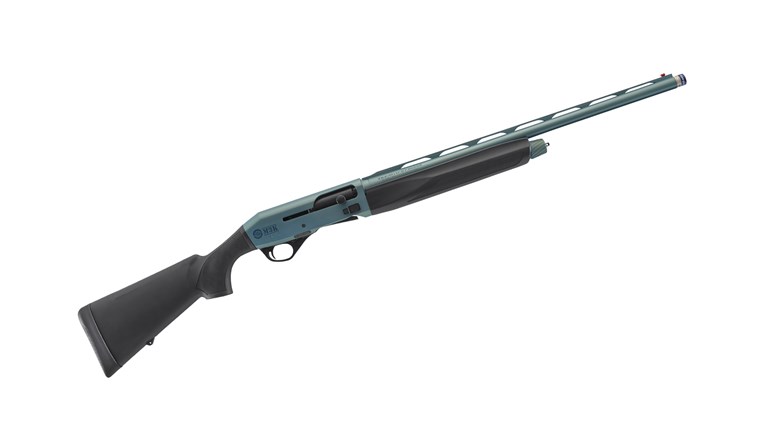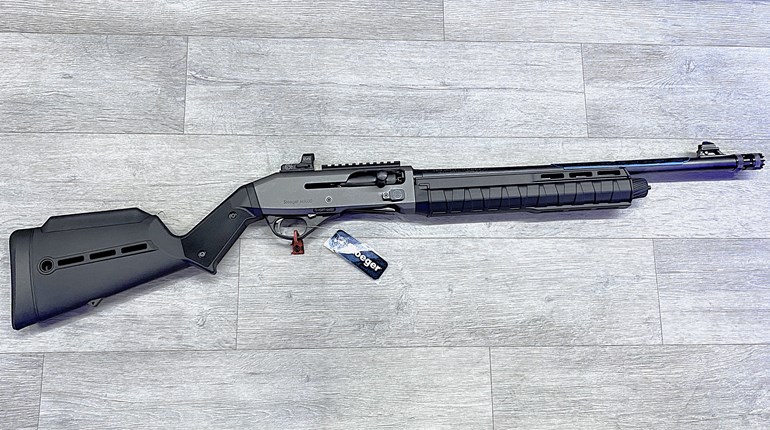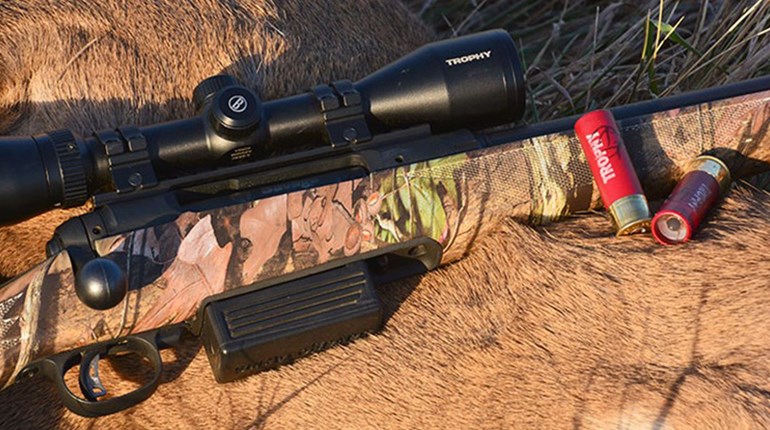I’ve long admired double guns from afar, this distance being best for both my pocketbook and the gun itself. I’m naturally hard on gear, and the very thought of handling a fine double gives me a nervous tic as I assume I’ll do something to damage it. Taking one afield is almost unthinkable, especially waterfowling where I generally find myself lying out in a muddy field for geese or banging around a makeshift duck blind. So acquiring a double gun, though it is every serious shotgunner’s dream, had been off-limits. Then I came across the Stoeger Uplander Longfowler, and it reminded me the idea of a double-barrel shotgun, like so many other things, can be much different than the reality.
No work of art, the Stoeger Longfowler side-by-side possesses a sort of brutal beauty, not unlike a well-made hammer. The barrels are of the obligatory 30-inch length, with an additional 3/4 inch added on via extended choke tubes that do nothing for the gun’s looks. Like the barrels, the square receiver is matte black with no engraving other than the standard model name and chambering details. Interestingly, my test model seemed to be suffering from an identity crisis; the right side of the receiver was faintly inscribed “Stoeger Longfowler S/S,” while the chamber of the left barrel bore the inscription “Uplander Supreme.” My guess is the factory—Brazil’s E.M. Amantino—uses the same monobloc for both Stoeger models, the pair belonging to the company’s Uplander line.
The stock and beavertail fore-end are of A-grade walnut, also in a dark matte finish that brings to mind the old market-gunning doubles of days gone by. My mother’s father passed down a 16-gauge Ithaca/Western Arms Long Range Double, and the Longfowler reminds me a lot of that side-by-side. Like the old Ithaca, the Stoeger is plainly adorned with pressed checkering at the wrist and along the fore-end, although it’s a bit too shallow to serve much purpose in terms of aiding grip.
If you’re paying less than $500 for a side-by-side shotgun, don’t expect the same kind of fit and finish you’d find on a high-grade double. It’s just not going to happen. The wood-to-metal fit on the Longfowler is adequate at best, with a slight bit of gapping where the fore-end wood meets the steel spacer. Tooling marks are minimal, however. Even the lines where the barrels join the monobloc are unobtrusive. Mass-produced doubles are going to vary in quality, so I suggest handling several to find one where the assembler in the factory took some pride in his or her work.
When I first pulled the Longfowler from the box, the action was stiff and I all but had to break the gun over my knee to open it. After just a few shots, it loosened up considerably before settling in to open with a motion that’s easy but by no means sloppy. One thing that has remained stiff is the single, non-selectable trigger, which fires the right barrel first at 61/4 pounds of pull weight and the left barrel at 71/2. The tang safety is solid and automatically resets upon opening. The Longfowler is also fitted with extractors that never failed to lift magnum loads from the chambers, even when those chambers exhibited extreme fouling from extended use between cleanings. Stoeger installs improved cylinder and modified choke tubes, though I think a gun called the Longfowler should also come with a full choke for gunning high birds.
In addition to its longevity under repeated pounding and hard use, the real test of a value-driven double gun is barrel regulation, or the ability of each barrel to hit as close to the same point of aim as possible. Due to the difference in chokes, shot variance and a host of other factors, absolute regulation is hard for manufacturers to accomplish and test with any reliability, but a good side-by-side should at least show some pattern convergence at a range appropriate for the gun’s intended use.
Since Stoeger chose the name Longfowler for this shotgun, I decided to test barrel regulation at 40 yards—a bit longer than I would with a gun more suited for upland bird hunting. My thought is this gun in its 12-gauge configuration would be better suited for pass-shooting Canada geese or bringing down big divers skirting the dekes. If I were decoying puddle ducks, I’d probably opt for the 20-gauge version.
The patterning board was a 25-inch circle with a 2-inch triangle in the center. I shot both barrels with the modified choke, stuffing them with a 1-ounce load of No. 7 1/2 lead shot for testing purposes. That gave me an estimated total pellet count of 350 per round. During testing, I was somewhat surprised to find each barrel shared the same point of impact, putting between 120 and 125 pellets, or about 35 percent, in the circle each time. Interestingly, that point of impact was just about 2 inches right of center, with the right half of the target absorbing 20 to 25 percent more shot than the left.
While the patterns were consistent, they were a little more open than I’d prefer. If I were relying on the Longfowler all season long, I’d invest in a good set of waterfowl-specific chokes such as those from Trulock or Patternmaster. With an MSRP of $499 and a street price a little over $400, the Longfowler leaves some room in the budget to take it from an adequate fowling piece to a good one with a couple choke tubes.
Like any working tool should, the Longfowler swings like a hammer in your hands, too, with a balance point just forward of the hinge. Belying its weight, the gun starts fairly easily and changes direction without much effort, helping the shooter toward crossing doubles. With the Longfowler registering nearly 8 pounds on the scale, I wouldn’t want to carry it while walking up pheasants in the uplands, but it proved perfectly suitable last season over the water and in the goose fields.
I really appreciated the fact that I never felt like I had to baby the Longfowler in any way. It spent most of the waterfowl season lying next to me in muddy cornfields or propped in the corner of a dirty blind in all manner of weather conditions. Through several boxes of loads, from Federal Black Cloud to Remington Hyper-Sonic and Kent Fasteel, it only failed to fire once. Now, once might be once too many, but I consider it acceptable in the case of a sub-$500 side-by-side that never so much as got close to a cleaning rod for three months. That kind of consistency should be considered a blessing to those of us who view such a gun as a tool, rather than a work of art.
 Technical Specifications:
Technical Specifications:
Type: boxlock double-barrel shotgun
Gauge/Chamber: 1 2/3" (tested); 20/3"
Barrels: 30"; solid rib, threaded for choke tubes
Sights: front brass bead
Safety: tang-mounted, automatic
Stock: A-grade walnut, satin finish; LOP 14.5"; drop at heel 2.5"; drop at comb 1.5"
Metal Finish: matte black
Overall Length: 47.5"
Weight: 7 lbs., 15 oz.
MSRP: $499





































